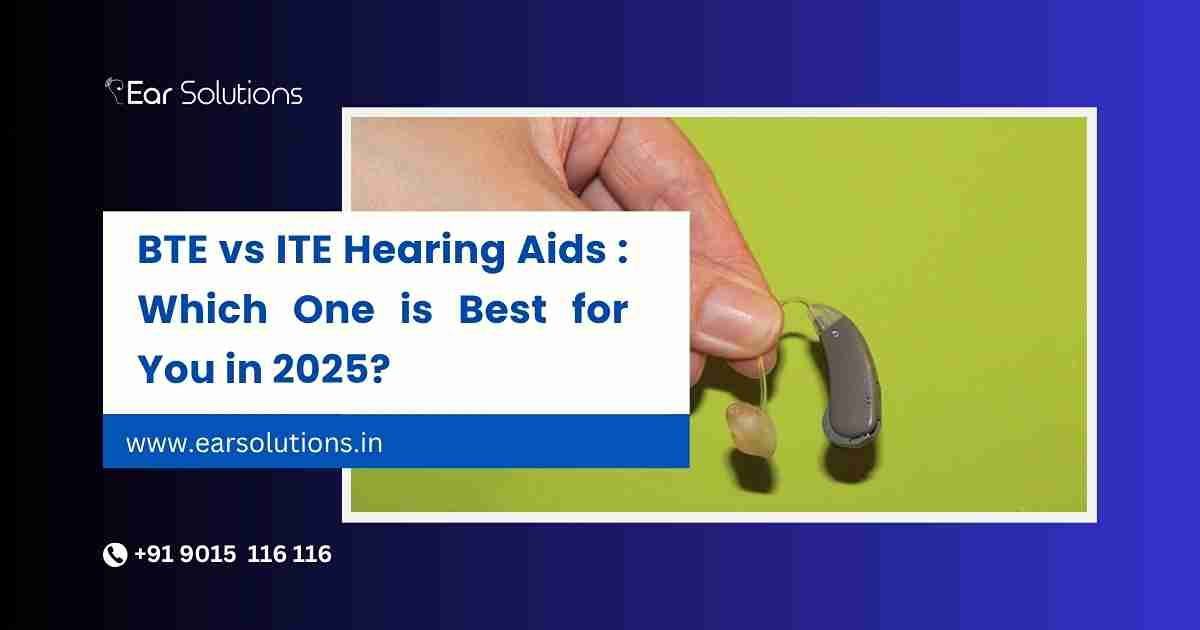
Choosing the right hearing aid can make a world of difference in improving your hearing and overall quality of life.
Choosing the right hearing aid can make a world of difference in improving your hearing and overall quality of life. In 2025, hearing aid technology has advanced significantly, offering users more personalised and comfortable solutions. Two of the most popular styles are BTE (Behind-the-Ear) and ITE (In-the-Ear) hearing aids. Both come with their benefits and are suited for different levels of hearing loss and lifestyle needs. So, which one is best for you? Let’s compare them based on key factors.
What are BTE Hearing Aids?
BTE hearing aids sit comfortably behind the ear and are connected to an earmold or dome that fits inside the ear canal. This design is ideal for people with mild to profound hearing loss.
Key Benefits of BTE Hearing Aids:
Powerful Amplification: Suitable for all levels of hearing loss, especially severe to profound.
Durability: Larger size means more robust components and longer battery life.
Rechargeable Options: Most modern BTE models in 2025 come with fast-charging and long-lasting batteries.
Bluetooth Connectivity: Easy pairing with smartphones and TVs for direct audio streaming.
Easier Handling: Ideal for seniors or users with dexterity issues due to their larger size.
What are ITE Hearing Aids?
ITE hearing aids are custom-made to fit inside your ear. They are more discreet than BTEs and are recommended for individuals with mild to severe hearing loss.
Key Benefits of ITE Hearing Aids:
Discreet Design: Sits completely in the ear, making it less noticeable.
Natural Sound Experience: Placement inside the ear uses the ear’s natural shape to localise sound.
Easy Phone Use: No obstruction behind the ear, making it more comfortable for phone conversations.
Custom Fit: Made specifically for your ear canal for better comfort.
Comparison Between BTE and ITE Hearing Aids
When it comes to visibility, BTE hearing aids are slightly more noticeable as they rest behind the ear with a tube connecting to the ear canal. In contrast, ITE hearing aids fit directly into the ear and are more discreet, making them a popular choice for users who prefer a less visible option.
In terms of power level, BTE hearing aids offer a wider range of amplification, making them suitable for individuals with mild to profound hearing loss. ITE hearing aids, while still powerful, are generally best for those with mild to severe hearing loss.
Ease of use is another important factor. BTE hearing aids are easier to handle due to their larger size, which is beneficial for seniors or individuals with dexterity challenges. On the other hand, ITE hearing aids are smaller and can be slightly more difficult to insert or adjust, especially for those with limited hand mobility.
Both types offer access to advanced technology, including Bluetooth connectivity, noise reduction, and artificial intelligence features. However, BTE models tend to have more space to accommodate larger processors and additional features. ITE hearing aids also support similar tech, but within a more compact design.
Regarding battery life, BTE devices typically support larger, longer-lasting batteries or rechargeable options that last all day on a single charge. ITE hearing aids, due to their smaller size, may have shorter battery life and may not always support rechargeability, depending on the model.
Conclusion: Which One is Right for You?
Your choice depends on your degree of hearing loss, lifestyle, and comfort preferences. If you need a powerful device with maximum amplification and advanced features, BTE hearing aids are a great option. On the other hand, if discretion and comfort are your priorities, especially for mild to moderate hearing loss, ITE hearing aids may suit you better.
Before making a decision, consult with a qualified audiologist. At Ear Solutions, we offer free hearing tests, expert advice, and trial sessions to help you find the perfect fit in 2025’s most advanced hearing solutions.
© 2024 Crivva - Business Promotion. All rights reserved.